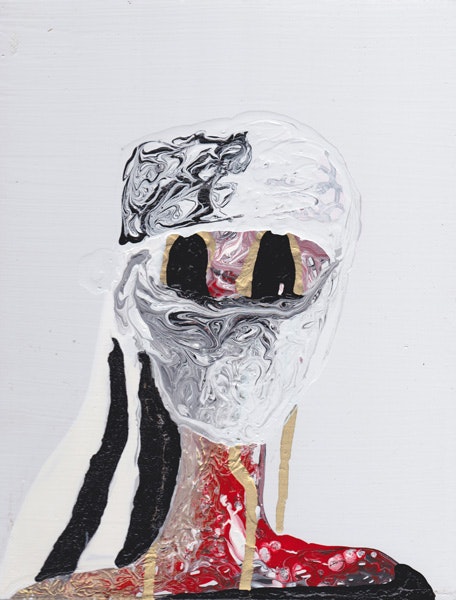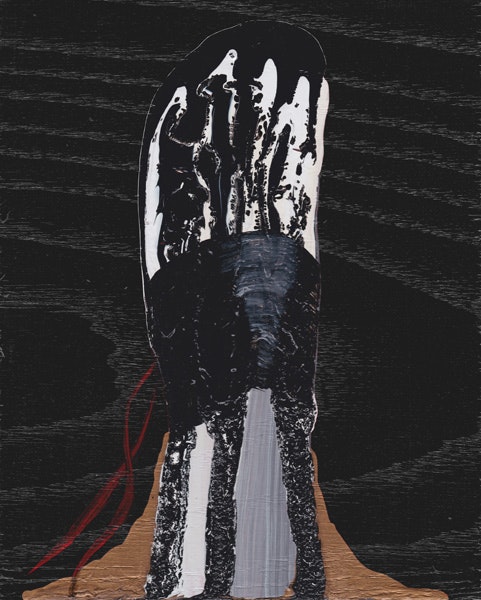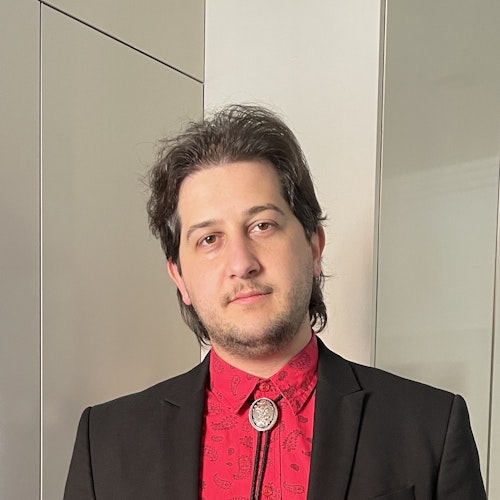This is my coup d’etat: k-pop and creative control
Con Gerakaris

OWVBICS, COUP D’ETAT ‘The Red’, 2013, latex on panel, 25.4 x 30.5 cm; courtesy the artist.
In mid-September 2012 I unintentionally caught the premiere of PopAsia, SBS TV’s Asian pop music video program. Truthfully and totally devoid of irony, it changed my life.
While in my pretentious peak of listening to abstract Afrofuturist hip-hop, writing academic essays on revered Japanese noise music god Merzbow, and studying the aggressively better-than-thou serialist compositions of Arnold Schoenberg, k-pop was an otherworldly burst of joyful indulgence. What started as a guilty pleasure soon became an obsession despite not knowing a shred of Korean language. Music videos (MVs) held irresistible allure, with perfectly manicured (or is that mannequined?) plastic people singing, rapping and dancing with infectious energy after being churned through a gruelling manufacturing process by faceless entertainment companies.
K-pop MVs and music moves in waves. At present, many groups have a post-EDM sound: big electronic drums, big sawtooth-wave synths and big drops with a sprinkling of trap rap lifted directly from the strip clubs of Atlanta to the Innisfree stores of Myeong-dong. By 2012 the sound was a cleaned-up adaptation of French electro-house, a sweaty genre of frenetic disco sampling and borderline raw synthesiser noise that pretty much defined clubbing late last decade. MVs similarly followed suit, with groups often emulating each other in set design, choreography, costume and concept (the Beats by Dre headphones phase around the turn of the decade immediately comes to mind). Yet in this bubbling mass of sickly sweet key changes and fashionista rappers there are k-pop idols taking their careers into their own hands, and doing so through contemporary art.
Tracing the artistic concepts of MV set design is a project that would result in a tale of epic proportions akin to The Odyssey, so this piece has been tightly restricted to focus on G-Dragon and T.O.P, the two most prominent members of BIGBANG, the poster boys of k-pop. Their efforts to legitimise their artistic profile places them leagues ahead of their contemporaries. While the members of the record-breaking BTS were snapped posing with KAWS’ sculptures at Galerie Perrotin, T.O.P became the first collector to curate in collaboration with Sotheby’s Hong Kong; where Yoon Jong Shin featured JonOne in The First MV, G-Dragon was in Manhattan meeting with emerging artists viewing works from the back of a van.
Yet in this bubbling mass of sickly sweet key changes and fashionista rappers there are k-pop idols taking their careers into their own hands, and doing so through contemporary art.
Undeniably the first name that comes to mind in regards to the collision of k-pop with fine art, T.O.P proudly puts his love for art in the public eye. His personal Instagram account largely consists of flat photographs of art devoid of captions, and often name-drops in his lyrics (‘Francis Bacon in my kitchen’ is a personal favourite). Held on 3 October 2016, #TTTOP was a contemporary art sale and exhibition at Sotheby’s Hong Kong which resulted in the highest-value sale of Western contemporary art in a major Hong Kong auction series. While earnest in aim and successful in result, the artists featured in #TTTOP read more like a checklist of some of the most dominant figures of the past 40 years: Jean-Michel Basquiat, Keith Haring, Lee Ufan, Gerhard Richter, Takashi Murakami, Paik Nam June. Selecting 28 works, T.O.P demonstrated his knowledge of the critical artists of our time while championing emerging artists such as Tauba Auerbach and Teppei Kaneuji, allowing the strikingly handsome rapper and actor to become a genuine influencer outside of music and fashion.
After finding inspiration in T.O.P and using his silhouette for Trans-T.O.P (2013), the k-pop sensation and eminent Japanese artist Kohei Nawa became friends. Bouncing inspiration off each other, Nawa’s PixCell-Deer was present in the promiscuously psychedelic BAE BAE MV and in return, the artist created PixCell-T.O.P (DOOM DADA) (2016), a custom crystallised artwork using a figure from BIGBANG’s Art Toy’ collectables, themselves created in a collaboration between YG Entertainment and Hong Kong artist Eric So. Sold at auction for US$72,540, the one of a kind piece depicts T.O.P in costume from the DOOM DADA MV, an overwhelmingly silly video which achieves little more than showing off his good looks. Despite existing only as a ludicrously priced 20 cm figurine, PixCell-T.O.P (DOOM DADA) represents T.O.P’s genuine love of art, reflecting upon the superstar as a multifaceted creative with far more to offer than romantic raps and beer endorsements.
Trying not to sound too cynical, where T.O.P’s head-first dive into the art world seems driven by personal motivation, bandmate and all-round Pharrell Williams of South Korea G-Dragon (or ‘GD’) often uses contemporary art as compliment to his music and brand. His second solo album COUP D’ETAT comes off as one of the most artistically consistent and self-guided k-pop projects outside of the k-indie scene. Conceptually based in his ‘Peace Minus One’ philosophy of striving for perfection while understanding your flaws, GD personally selected the work of Venezuelan-born New York City-based post-graffiti artist Harif ‘Haculla’ Guzman and commissioned a series of expressionist portraits from emerging American painter OWVBICS to demonstrate the concept and aesthetic of his pop music record. The striking COUP D’ETAT MV was created at Kokiri Art Centre, Namyangju and involves a number of elaborate, melodramatic sets and props, with one set populated by Guzman’s signature One of A Kind motif and a large scale custom mural.
In a conversation I had with OWVBICS regarding the project, he explained how organic GD’s work process was, choosing not to rely on a big name but rather encourage an artist he was certain would produce authentic works that reflected his creative output. For the commission, the artist produced an extensive body of work of highly stylised portraits of G-Dragon in his ninja costume, an integral part of the album concept. Of the 137 G DRAGON paintings, three were selected to be included in the CD booklets for the three colour-specific versions of the album. His portraits are painted in an aggressive, visceral and confronting style, reflecting the artist’s oeuvre while keeping the content in check given the nature of the project. Painted on wood, OWVBICS’ application is purposefully uneven, toying with painterly textures while abstracting the portrait form through heavy, saturated colour blocking. Upon revisiting his art, the artist praised GD for his courage and determination to follow his creative goals, selecting artworks deemed confronting by his fanbase to be an intrinsic part of this chart topping album and taking full creative control from YG Entertainment.

OWVBICS, COUP D’ETAT ‘The White’, 2013, latex on panel, 25.4 x 30.5 cm; courtesy the artist.

OMVBICS, COUP D’ETAT ‘The Black’, 2013, latex on panel, 25.4 x 30.5 cm; courtesy the artist.
Following COUP D’ETAT came PEACEMINUSONE, an ‘experimental exhibition’ (their own words) of South Korean and international contemporary artists presenting new works inspired and based around G-Dragon. Held at the Seoul Museum of Art in 2015, PEACEMINUSONE brought together a concoction of unique artists tasked to make new work that directly engaged with and referenced GDs music in their own idiosyncratic style. Eminent South Korean photographic sculptor Osang Gwon appropriated a 15th Century cathedral sculpture of the Archangel Michael slaying Satan as a dragon, composed in the most typical fashion, to feature GD driving a golden spear-cum-microphone stand into an animalistic form of himself. French artist Fabien Verschaere employed his playful yet creepy comic-style typography to what are essentially the English buzzwords lifted from GD lyrics, while South Korean audio-visual artist duo Bang & Lee reinterpreted the concert stage to illustrate how superstars are transformed through media in one of the more successful artworks in the show. If you are rolling your eyes into the back of your head in an attempt to comprehend the self-indulgence and over the top nature of PEACEMINUSONE, rest assured: you are not alone. Considering the sincerity and autonomy G-Dragon brings to his sculpted creative output, the exhibition reads as the manufactured musician’s attempt to not only crossover into the art world but also a shedding of his created skin to legitimise Kwon Ji-yong (GD’s real name) as an artist who warrants and deserves our respect.
Taking a step back from the auction house and art gallery, there is one final musician that must be mentioned in regards to the niche topic of contemporary art and k-pop coming together: Hitchhiker. An established in-house producer and hitmaker for S.M. Entertainment, Hitchhiker has recently released three club ready tracks, 11, $10 and Ding Dong with accompanying MVs of internet art bliss. Once known by the name Jinu, Hitchhiker is a faceless persona represented by a polygonal beekeeper figure rendered in reflective silver texture. MVs feature the character and other digital beings dancing in dull backstreets of Seoul ripped from Naver Maps (South Korea’s answer to Google Maps) and stretched to create 3D rendered spaces. The $10 MV is a smattering of purposefully bad surrealist CGI and augmented reality collage synced to a grating repetitive vocal sample backed by obnoxious 808 drums. This MV alone is more than enough to pass judgment on the project, however I recommend viewing the other two MVs and the bemusing Hitchhiker trailer. Often seen as weird for weird’s sake by netizens, Hitchhiker as a creative project is flipping k-pop idol worship back on the consumers themselves through an aesthetic that immediately brought to mind Hito Steyerl’s How Not To be Seen: A Fucking Didactic Educational .MOV File (2013).
The Trailer: The Story of Hitchhiker is a short mockumentary in which musicians (although in reality just paid actors) from South Korea and abroad shower praise on the artist despite not having released a single song. The interviewees speak English, Korean, French, Japanese and more while the subtitles in English and Korean read as terrible Google Translate gibberish over doctored images of Hitchhiker on billboards and bus stop advertisements. The project is reminiscent of Gorillaz in regards to the obfuscation of reality through the style of contemporary net art microscenes, most notably vapourwave. And while Hitchhiker’s music does little to promote any artistic subversion of South Korea’s hypercapitalistic way of life, the MVs read as bizarre digital artworks in of themselves, jovially and shamelessly self promoting an avatar which so blatantly pokes fun at the system all from within the system. And yet, in the truest sense, Hitchhiker has quickly become a case of life imitating art, with the shimmering beekeeper figure making a real-life appearance at South By Southwest Festival’s K-pop Night Out in 2015 alongside some of the biggest names in the South Korean music scene.
As k-pop music steadily becomes global in reach and sound, ushering in a new wave of superstars, it is unlikely we will ever see figures like T.O.P and G-Dragon emerge from the firm grip of industry executives. BIGBANG was an unprecedented success story and these two manufactured South Korean rappers rode the hallyu wave to remarkable heights. And while there is movement in the independent scene, it appears impossible this revolution will be televised again.
About the contributor
Con is a curator, arts administrator and writer and currently is the Curatorial Program Manager at 4A Centre for Contemporary Asian Art.
